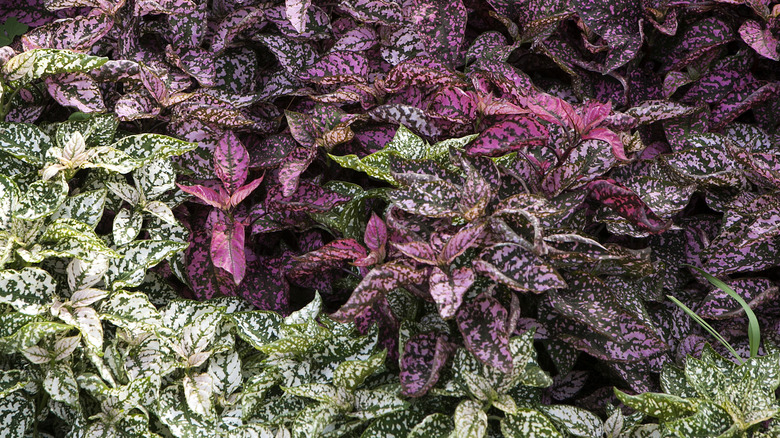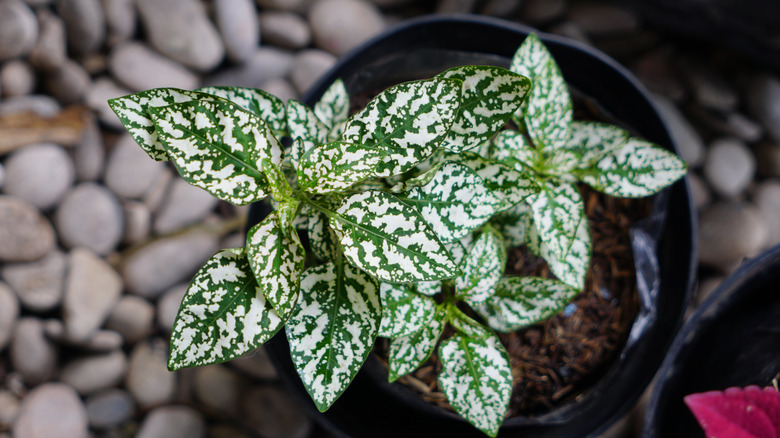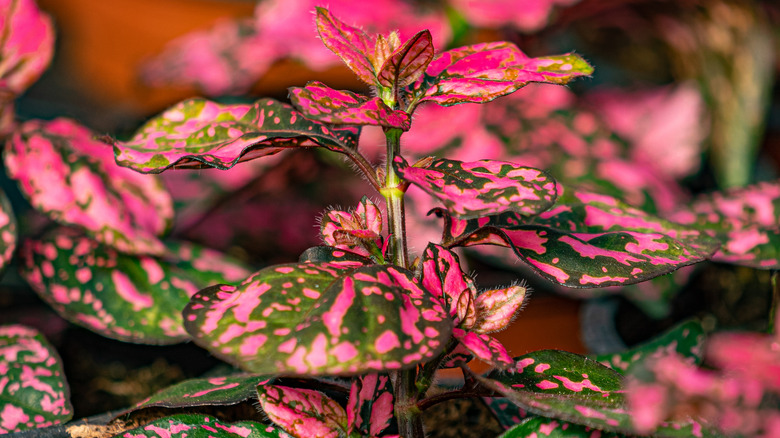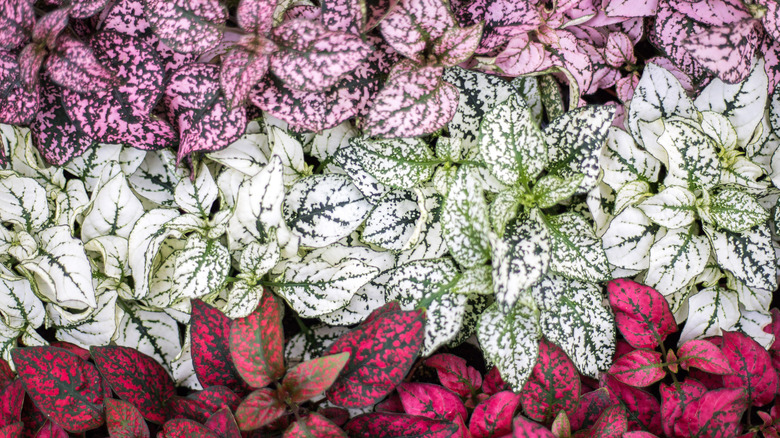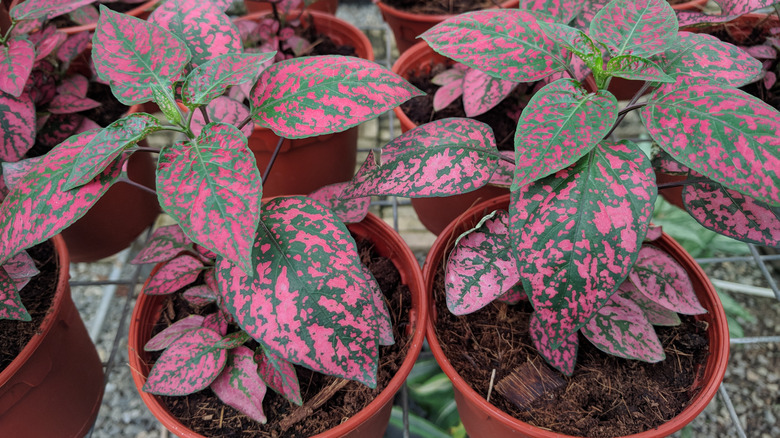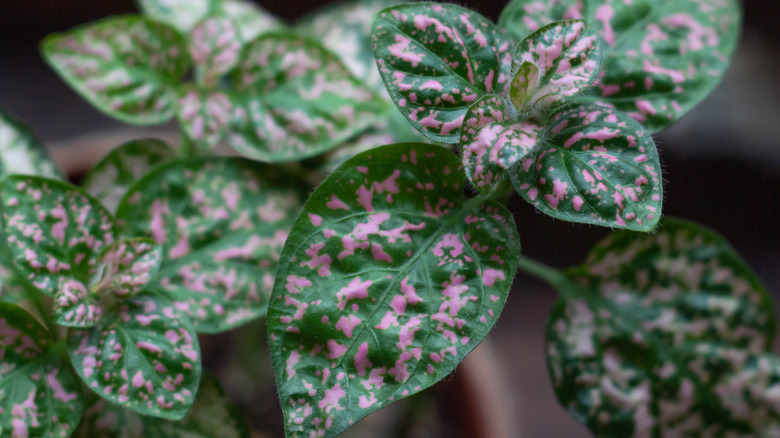How To Successfully Grow A Polka Dot Plant
Hypoestes phyllostachya, also known as the polka dot plant, is an herbaceous perennial. Native to Madagascar, South Africa, and Southeast Asia, this plant loves warm weather and humidity, as per Plant Legend. Because of this, it is a great houseplant if you live in the colder regions of the U.S., especially since it is nontoxic to pets and humans.
The polka dot plant is characterized by its small stature and spotted leaves. The common polka dot plant has green leaves with pink spots, but you can find varieties with white, rose, or red coloring. Sometimes, the spots will become so prominent that the entire leaf will appear pink, rose, or red. Because of its unique pattern, this plant is also referred to as the flamingo plant, the pink dot, the freckle face, or the measles plant. The bright polka dot plant also flowers occasionally, says The Spruce. In the late summer and early fall, you can find small purple blooms on your plant. These flowers appear as individual blooms, and they have a tubular shape similar to honeysuckle blooms.
How to use a polka dot plant in the garden
When growing polka dot plants outdoors, many gardeners treat theirs as annuals since they can't tolerate cold weather. Plant them in the spring after the last frost and allow them to die as the temperatures drop below 50 degrees Fahrenheit in the fall. Indoors and outdoors, polka dot plants stay relatively small, only growing a bit larger than 1 foot high and wide, as explained by Garden Design.
Outdoors, polka dot plants can be used as accent plants in the garden or as border plants. Some also choose to keep theirs in containers outside during their region's warmer seasons and bring them back inside when it's cold. They make great additions to the garden since they are deer resistant and seldom bothered by pests. Polka dot plants do best in indirect light, so when choosing a site for them in your garden, consider placing them as ground cover under a large tree or as underplantings in garden beds.
How to grow a polka dot plant
To grow a polka dot plant, you'll need rich, well-draining soil with perlite to supplement draining even further. You can propagate this plant from seeds or cuttings. It can prove difficult to find seeds for germination, which is why most people go for the latter option. When growing from seeds, gently press several seeds into warm, moist soil in a tray. Place this container in an indirectly sunny window and consider covering it with plastic wrap to accelerate growth, suggests Gardening Know How. Remove the wrap after they sprout, and wait a few weeks until they are large enough to transplant into a larger pot.
Growing a polka dot plant from cuttings is even easier. With sterile scissors, cut a 4-inch piece of stem from your plant, making sure that it includes at least one leaf node. If there are any leaves close to the end, pull them off. Then, place your cutting in a glass of water which you will replace once per week. After some time, your cutting will begin to grow a new root system. But, you shouldn't take it out of its glass until its roots are more than 2 inches long, as per The Spruce. Once the growth is long enough, plant your cutting into a rich potting mix and cover it with plastic wrap until its new roots have taken hold. You may repot again once your propagated polka dot plant has grown several more inches.
How to care for a polka dot plant
Polka dot plants can be difficult to care for when you are a beginner gardener. They require a lot of maintenance and attention. As the owner of a polka dot plant, you can expect to water it more than twice a week and constantly work to give it the humidity it needs, according to Evergreen Seeds. You should never let its soil completely dry out. If you do, your plant will begin to wilt. Check the moisture of your polka dot plant's soil daily, and when the top half-inch dries out you should water generously until water runs out of the pot's drainage hole.
This plant loves bright indirect light when grown indoors. It can handle some shady areas but be warned, your plant will likely lose much of its bright color when living in this environment. To keep its beautiful variegation, make sure it gets plenty of indirect sunlight during the day. To further encourage healthy growth, you may fertilize your polka dot plant. Gardening Know How suggests feeding the freckle face once per month. Use an organic houseplant fertilizer during its growing season for best results.
Polka dot plant varieties
The Hypoestes genus hosts more than 100 different flowering species of plants, many used as ornamental plants with uniquely colored leaves, tells Gardening Know How. Within the Hypoestes phyllostachya species, there are also many cultivars. Each is bred for a different leaf coloration. Some have many bright spots while others are entirely covered with large splotches. Here are a few of the most popular varieties as told by Home Stratosphere.
-
"Red Splash" is a color of the splash series, featuring glossy dark green leaves taken over by true red spots.
-
"Pink Dot" looks as though it is a part of the splash series, this variation is characterized by green leaves with pale pink spots and splotches all over.
-
"White Splash" is similar to "Pink Dot," the polka dot plant has light green leaves with large white markings.
-
"Carmina" can often be confused for "Red Splash." Its distinctive characteristic is the carmine red color of its variegation.
-
"Pink Brocade" is a variety of the polka dot plant that is overwhelmed by pink patches. Usually, some of its leaves are entirely pink.
-
"Confetti" is characterized by smaller dots of color on its leaves compared to the other variations. These cultivars may be lightly speckled with white, pink, burgundy, or red dots.
How to repot a polka dot plant
You do not need any special knowledge to repot a polka dot plant. Like most houseplants, they need repotting every one or two years to avoid becoming pot-bound. The best time to repot is in the early spring before its growing period. According to The Spruce, the new pot you plan to repot with should only be a couple of inches larger than the last. This plant does not enjoy having too much excess soil that could retain water. A pot that is too large can lead to root rot and other problems.
When you are ready to begin repotting, have a rich potting soil mix handy. Begin by carefully unpotting your plant and teasing excess soil from its roots. If your plant is already pot-bound, you may need a flat tool to release it from its pot and a gardening fork to break up the root ball. After that, place your polka dot plant into its new container with plenty of new soil. Pack the dirt gently on top of its roots so that your plant is secure. Water it generously until water runs from the drainage hole and place the polka dot plant in a bright window with indirect sunlight. Don't forget to throw out excess water in the plant's saucer to reduce the risk of root rot.
Polka dot plant's common pests and problems
Such is the case with other houseplants, polka dot plants are susceptible to thrips, mealybugs, and spider mites, as explained by Evergreen Seeds. If you notice that your plant's leaves are looking unhealthy, look for signs of these pests under each of its leaves. If you find tiny white or brown insects or small webs, you likely have an infestation on your hands. Luckily, the solution is simple. Spray rubbing alcohol, neem oil, or insecticidal soap on your plant to kill the bugs, says Simplify Gardening. Determined pests may need to be wiped away with a cotton ball soaked in one of these solutions.
Other problems you may have with this plant include leaves losing their color, wilting, or dropping off entirely. This can be caused by a range of issues. Ensure that your plant is in a bright, but indirectly sunny spot. Too much light or too little light can cause foliage to fade or curl. If this doesn't seem to be the problem, you could be overwatering your polka dot plant. Stick to a regular watering schedule, watering when the top half-inch of soil is dry. Too wet soil will often cause this plant's leaves to yellow and wilt, as per Garden Design. Alternatively, your issue may be the opposite. Not enough water or humidity can force the leaves to turn brown and drop. Always be sure to mist your polka dot plant regularly and never let the soil completely dry out.

